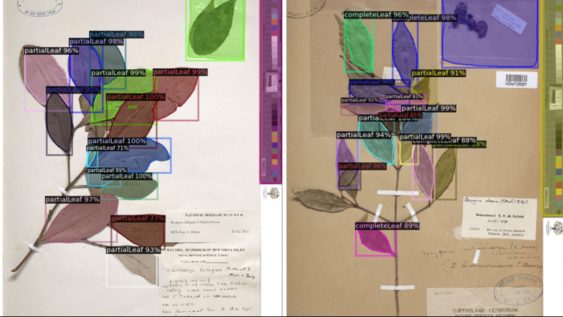TL;DR:
- Scientists from UNSW and Botanic Gardens of Sydney have trained AI to analyze plant specimens from herbaria worldwide.
- AI algorithms reveal that leaf size within a single species does not consistently increase in warmer climates, challenging previous assumptions.
- Herbarium collections have transitioned to the digital realm, allowing for global scientific collaboration and high-resolution imaging.
- Machine learning algorithms accurately detect and measure leaf sizes, enabling efficient analysis and documentation of leaf traits.
- The study uncovers the influence of gene flow on leaf size-climate relationships within species, providing new insights into plant adaptation.
- AI’s ability to predict climate change effects and identify hidden trends offers valuable opportunities for plant evolution research and conservation efforts.
Main AI News:
Cutting-edge research conducted by scientists from the University of New South Wales (UNSW) and Botanic Gardens of Sydney has introduced a groundbreaking application of artificial intelligence (AI) that promises to revolutionize the study and mitigation of climate change’s impact on flora. This pioneering endeavor involves training AI algorithms to extract invaluable data from millions of plant specimens meticulously preserved in herbaria worldwide.
Lead author Associate Professor Will Cornwell emphasized the significance of herbarium collections, describing them as remarkable time capsules of botanical specimens. With over 8,000 additions annually to the National Herbarium of New South Wales alone, the sheer volume of plant samples necessitates an automated approach. The manual examination is no longer feasible in this era of unprecedented data abundance.
Employing an innovative machine learning algorithm, the research team analyzed over 3,000 leaf samples and made a remarkable discovery: contrary to conventional wisdom regarding interspecies patterns, the size of leaves does not consistently increase with warmer climates within a single plant species. This revelation challenges preconceived notions and sheds light on the diverse factors influencing leaf size within plant populations. Furthermore, it highlights the potential of AI to transform static specimen collections into dynamic tools that enable rapid and effective documentation of climate change effects.
The remarkable transition of herbarium collections into the digital realm has been a crucial step in facilitating scientific collaboration. A few years ago, efforts were initiated to digitize these invaluable repositories, which were once confined to small boxes in specific locations. The global scientific community recognized the need to make information about these exceptional specimens accessible to researchers scattered across the globe. Consequently, an ambitious project commenced at the Botanic Gardens of Sydney, where over one million plant specimens from the National Herbarium of New South Wales underwent a remarkable transformation into high-resolution digital images.
Dr. Jason Bragg, one of the researchers from the Botanic Gardens of Sydney, expressed his enthusiasm for collaborating with A/Prof. Cornwell explores the incorporation of machine learning techniques into the analysis of these digitized herbarium images. Their joint efforts focused on developing models capable of detecting leaves in the scanned plant images and subsequently using the vast datasets to investigate the relationship between leaf size and climate.
The algorithm they devised, underpinned by a convolutional neural network—a form of AI known as Computer Vision—enables automated detection and measurement of leaf sizes in herbarium samples from two plant genera: Syzygium and Ficus. This transformative AI system learns to perceive and identify the various components of a plant, much like a human observer would.
While measuring leaf sizes is not an entirely novel practice, the speed at which these specimens can now be processed and their individual characteristics logged represents a groundbreaking development. The machine learning model built by A/Prof. Cornwell, Dr. Bragg, and UNSW Honours student Brendan Wilde allow for efficient analysis and documentation of leaf traits, utilizing the immense potential of AI in the field of botany.
The research team’s findings challenge a long-standing assumption in botany that larger leaves are associated with wetter climates, such as tropical rainforests, while smaller leaves prevail in drier environments like deserts. Although this pattern holds true when comparing different plant species, the team’s investigation of single species across the globe revealed a surprising break in the correlation. The machine learning algorithm, empowered by a wealth of new data, exposed a different process known as gene flow that weakens plant adaptation on a local scale. This process appears to hinder the development of a consistent leaf size-climate relationship within species.
Beyond its role in leaf detection and measurement, the AI-powered approach exhibited sufficient accuracy to explore links between leaf traits and climate. Associate Professor Cornwell emphasized the utility of these machine learning methods in documenting climate change effects, given the rapidly changing world and the vast amounts of available data. Moreover, these algorithms have the potential to uncover trends that elude human researchers, offering novel insights into plant evolution and adaptations. Ultimately, they could even provide predictions regarding plant responses to the future effects of climate change.

The machine learning algorithm developed by the research team measures and identifies plant specimens. Source:
Media Office, UNSW Sydney NSW 2052 Australia
Conclusion:
The integration of AI into botanical research and climate change studies has significant implications for the market. The use of machine learning algorithms to unlock the knowledge stored in herbaria and analyze plant specimens opens up new avenues for scientific exploration, conservation initiatives, and climate change mitigation strategies. This innovative approach not only enhances our understanding of plant adaptations but also provides valuable insights for industries related to agriculture, biodiversity conservation, and environmental consulting. Leveraging the power of AI in these fields will foster sustainable practices, inform decision-making processes, and contribute to the preservation of our planet’s precious flora.

